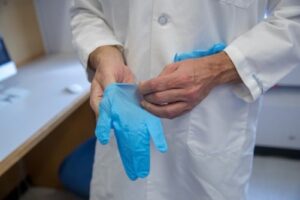
Traumatic brain injuries (TBIs) have persistently impacted military service members, with the Department of Defense reporting nearly 516,000 cases globally from 2000 to 2024. In response, a collaborative effort by researchers from the Johns Hopkins Applied Physics Laboratory (APL) in Laurel, Maryland, and the Johns Hopkins Bloomberg School of Public Health is underway to develop a cutting-edge brain organoid platform. This initiative, known as the Platform to Optimally Study Injury and TRauma On Neural Integrity and Circuitry (POSITRONIC), seeks to address the complexities of low-level blast injuries.
The research, published in Frontiers in Bioengineering and Biotechnology, delves into the fundamental concepts behind platforms specifically designed to study low-level blast exposure. “The cumulative effect of low-level blast exposures is not well understood because of the lack of ability to measure subtle effects on the human body, which may first manifest immediately after exposure but ultimately can evolve over long periods of time,” stated Katy Carneal, assistant program manager for Biological and Chemical Sciences at APL.
Understanding the Impact of Low-Level Blasts
Low-level blasts generate pressure waves that penetrate the skull and interact with brain tissue. Repeated exposure to these blasts can lead to mild blast-induced traumatic brain injuries (mbTBI). Military and law enforcement personnel may encounter over 100 such blasts during certain training exercises, accumulating even more over their careers.
“Our goal is to develop a prototype platform to better understand the effects of mbTBI caused by repeated low-level blasts by leveraging advances in brain organoids and noninvasive optical imaging,” explained Eyal Bar-Kochba, chief scientist in APL’s Research and Exploratory Development Department (REDD) and principal investigator for POSITRONIC. “In doing so, we hope this research will help pave the way for advancements of preventative measures, improved diagnosis, and treatment options.”
Next-Generation Platforms: The Role of Brain Organoids
Historically, researchers have relied on in vivo models, which involve live animals, and in vitro models, which use simpler cell cultures grown in a lab, to study TBIs. However, translating these findings to humans has proven challenging due to the limited human relevance of these models. This is where brain organoids come into play, offering a promising in vitro model derived from human cells.
A significant advantage of brain organoids is their ability to replicate complex neural networks and cellular interactions. Neurotoxicologists Thomas Hartung and Lena Smirnova from the Bloomberg School have been pivotal in developing these organoid platforms for trauma research. The POSITRONIC team is at the forefront of using brain organoids to investigate the effects of repeated low-level blast exposures.
“This underscores the versatility of organoids as an alternative to animal testing, providing a model for investigating yet another complex disease,” said Smirnova, assistant professor at the Bloomberg School. Once cultivated, the brain organoid is integrated with a pressure-generation system, enabling researchers to simulate repeated low-level blast exposures at pressures akin to those experienced by many service members during training.
Implications and Future Directions
The development of this brain organoid platform represents a significant step forward in understanding and mitigating the impact of TBIs on military personnel. By providing a more accurate model for studying the effects of blast exposures, researchers hope to uncover new insights into preventative measures and treatment options.
Furthermore, the implications of this research extend beyond military applications. The advancements in brain organoid technology could lead to broader applications in neuroscience, offering new avenues for studying a range of neurological conditions.
As the POSITRONIC project progresses, the research community and military health officials alike will be watching closely, hopeful that these innovations will lead to tangible improvements in the diagnosis and treatment of TBIs. The ongoing collaboration between APL and the Bloomberg School highlights the importance of interdisciplinary efforts in tackling complex health challenges.
For more detailed information, the research by Eyal Bar-Kochba et al., titled “Advancing next-generation brain organoid platforms for investigating traumatic brain injury from repeated blast exposures,” is available in Frontiers in Bioengineering and Biotechnology (2025). DOI: 10.3389/fbioe.2025.1553609.






